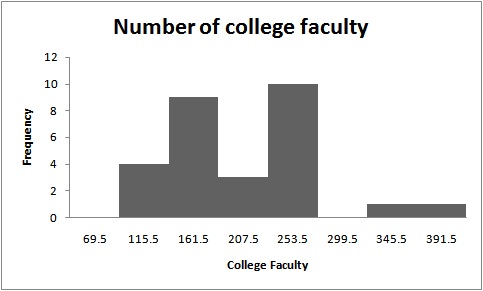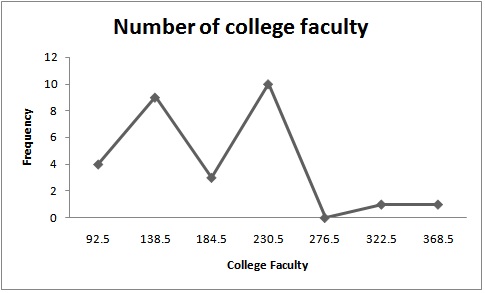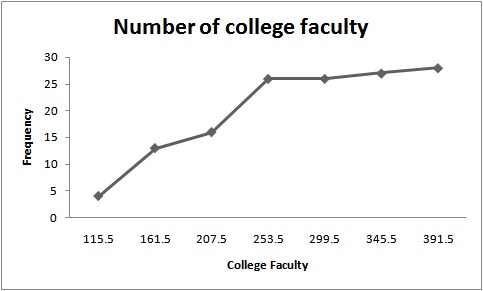
Number of College Faculty The number of faculty listed for a sample of private colleges that offer only bachelor’s degrees is listed below. Use these data to construct a frequency distribution with 7 classes, a histogram, a frequency

A grouped frequency distribution with 7 classes and draw a histogram, frequency polygon, and ogive; the explanation of these shapes and calculate the proportions of schools that have 180 or more faculty.
Answer to Problem 4E
Output using EXCEL software is given below:
Histogram:

Frequency polygon:

Ogive:

The proportion of schools that has 180 or more faculty is 0.448.
Explanation of Solution
Given info:
The data shows the number of college faculty listed in the table is given below:
| 165 | 221 | 218 | 206 | 138 | 135 | 224 | 204 |
| 70 | 210 | 207 | 154 | 155 | 82 | 120 | 116 |
| 176 | 162 | 225 | 214 | 93 | 389 | 77 | 135 |
| 221 | 161 | 128 | 310 |
Calculation:
The class boundaries for any class are given by:
Where,
The grouped frequency distribution is as follows:
| Class limit | Class boundaries | Tally | Frequency |
| 70-115 | 69.5-115.5 |
|
4 |
| 116-161 | 115.5-161.5 |
|
9 |
| 162-207 | 161.5-207.5 |
|
3 |
| 208-253 | 207.5-253.5 |
|
10 |
| 254-299 | 253.5-299.5 | 0 | |
| 300-345 | 299.5-345.5 | | | 1 |
| 346-391 | 345.5-391.5 | | | 1 |
| Total | 28 |
The midpoint of class boundaries is obtained by adding lower and upper limit and dividing by 2.
The relative frequency is the ration of a class frequency to the total frequency. Cumulative relative frequency can also defined as the sum of all previous frequencies up to the current point.
| Class boundaries | Mid point | Frequency | Cumulative frequency |
| 69.5-115.5 | 92.5 | 4 | 4 |
| 115.5-161.5 | 138.5 | 9 | 13 |
| 161.5-207.5 | 184.5 | 3 | 16 |
| 207.5-253.5 | 230.5 | 10 | 26 |
| 253.5-299.5 | 276.5 | 0 | 26 |
| 299.5-345.5 | 322.5 | 1 | 27 |
| 345.5-391.5 | 368.5 | 1 | 28 |
The histogram is a graph that displays the data by using contiguous vertical bars of various heights to represent the frequencies of the classes.
| Upper Limit | Frequency |
| 69.5 | 0 |
| 115.5 | 4 |
| 161.5 | 9 |
| 207.5 | 3 |
| 253.5 | 10 |
| 299.5 | 0 |
| 345.5 | 1 |
| 391.5 | 1 |
Histogram:
Software procedure:
Step-by-step procedure to construct the histogram using EXCEL software is given below:
- Press [Ctrl]-N for a new workbook.
- Enter the data in column A, one number per cell.
- Enter the upper boundaries into column B.
- From the toolbar, select the Data tab, then select Data Analysis.
- In Data Analysis, select Histogram and click [OK].
- In the Histogram dialog box, select relative column in the Input Range box and select upper limit column in the Bin Range box.
- Select New Worksheet Ply and Chart Output. Click [OK].
The distribution is slightly symmetric as the histogram shows that majority of the data value fall around the mean of the data. And the frequency is maximum at 253.5 and minimum at 391.5.
Frequency polygon:
Software procedure:
Frequency polygons are a graphical device for understanding the shapes of distributions. They serve the same purpose as histograms, but are especially helpful for comparing sets of data.
Step-by-step procedure to construct the frequency polygon using EXCEL software is given below:
- Press [CTRL]-N for a new notebook.
- Enter the midpoints of the data into column A and the frequencies into column B including labels.
- Press and hold the left mouse button, and drag over the Frequencies (including the label) from column B.
- Select the Insert tab from the toolbar and the Line Chart option.
- Select the 2-D line chart type.
Ogive:
Software procedure:
Step-by-step procedure to construct the ogive using EXCEL software is given below:
- Create an ogive, use the upper class boundaries (horizontal axis) and cumulative frequencies (vertical axis) from the frequency distribution.
- Type the upper class boundaries (including a class with frequency 0 before the lowest class to anchor the graph to the horizontal axis) and
- Corresponding cumulative frequencies into adjacent columns of an Excel worksheet.
- Press and hold the left mouse button, and drag over the Cumulative Frequencies from column B.
- Select Line Chart, then the 2-D Line option.
The points plotted are the upper class limit and the corresponding cumulative frequency.
The observations are based on number of faculty is greater or equal to 180 given as:
| 224 | 204 | 210 | 207 | 225 | 214 | 389 | 221 | 310 |
The sum of the above observations is 2204.
The total observations for number of college faculty are given as:
| 165 | 221 | 218 | 206 | 138 | 135 | 224 | 204 |
| 70 | 210 | 207 | 154 | 155 | 82 | 120 | 116 |
| 176 | 162 | 225 | 214 | 93 | 389 | 77 | 135 |
| 221 | 161 | 128 | 310 |
The sum of all above observations is 4916.
The proportion is calculated by dividing 2204 with 4916, that is,
The value 0.448 is the proportion of schools that has 180 or more faculty
Want to see more full solutions like this?
Chapter 2 Solutions
ELEMENTARY STATS: STEP BY STEP - CONNECT
- At the same restaurant as in Question 19 with the same normal distribution, what's the chance of it taking no more than 15 minutes to get service?arrow_forwardClint, obviously not in college, sleeps an average of 8 hours per night with a standard deviation of 15 minutes. What's the chance of him sleeping between 7.5 and 8.5 hours on any given night? 0-(7-0) 200 91109s and doiw $20 (8-0) mol 8520 slang $199 galbrog seam side pide & D (newid se od poyesvig as PELEO PER AFTE editiw noudab temand van Czarrow_forwardTimes to complete a statistics exam have a normal distribution with a mean of 40 minutes and standard deviation of 6 minutes. Deshawn's time comes in at the 90th percentile. What percentage of the students are still working on their exams when Deshawn leaves?arrow_forward
- Suppose that the weights of cereal boxes have a normal distribution with a mean of 20 ounces and standard deviation of half an ounce. A box that has a standard score of o weighs how much? syed by ilog ni 21arrow_forwardBob scores 80 on both his math exam (which has a mean of 70 and standard deviation of 10) and his English exam (which has a mean of 85 and standard deviation of 5). Find and interpret Bob's Z-scores on both exams to let him know which exam (if either) he did bet- ter on. Don't, however, let his parents know; let them think he's just as good at both subjects. algas 70) sering digarrow_forwardSue's math class exam has a mean of 70 with a standard deviation of 5. Her standard score is-2. What's her original exam score?arrow_forward
- Clint sleeps an average of 8 hours per night with a standard deviation of 15 minutes. What's the chance he will sleep less than 7.5 hours tonight? nut bow visarrow_forwardSuppose that your score on an exam is directly at the mean. What's your standard score?arrow_forwardOne state's annual rainfall has a normal dis- tribution with a mean of 100 inches and standard deviation of 25 inches. Suppose that corn grows best when the annual rainfall is between 100 and 150 inches. What's the chance of achieving this amount of rainfall? wved now of sociarrow_forward
- 13 Suppose that your exam score has a standard score of 0.90. Does this mean that 90 percent of the other exam scores are lower than yours?arrow_forwardBob's commuting times to work have a nor- mal distribution with a mean of 45 minutes and standard deviation of 10 minutes. How often does Bob get to work in 30 to 45 minutes?arrow_forwardBob's commuting times to work have a nor- mal distribution with a mean of 45 minutes and standard deviation of 10 minutes. a. What percentage of the time does Bob get to work in 30 minutes or less? b. Bob's workday starts at 9 a.m. If he leaves at 8 a.m., how often is he late?arrow_forward
 Glencoe Algebra 1, Student Edition, 9780079039897...AlgebraISBN:9780079039897Author:CarterPublisher:McGraw Hill
Glencoe Algebra 1, Student Edition, 9780079039897...AlgebraISBN:9780079039897Author:CarterPublisher:McGraw Hill Holt Mcdougal Larson Pre-algebra: Student Edition...AlgebraISBN:9780547587776Author:HOLT MCDOUGALPublisher:HOLT MCDOUGAL
Holt Mcdougal Larson Pre-algebra: Student Edition...AlgebraISBN:9780547587776Author:HOLT MCDOUGALPublisher:HOLT MCDOUGAL Big Ideas Math A Bridge To Success Algebra 1: Stu...AlgebraISBN:9781680331141Author:HOUGHTON MIFFLIN HARCOURTPublisher:Houghton Mifflin Harcourt
Big Ideas Math A Bridge To Success Algebra 1: Stu...AlgebraISBN:9781680331141Author:HOUGHTON MIFFLIN HARCOURTPublisher:Houghton Mifflin Harcourt


